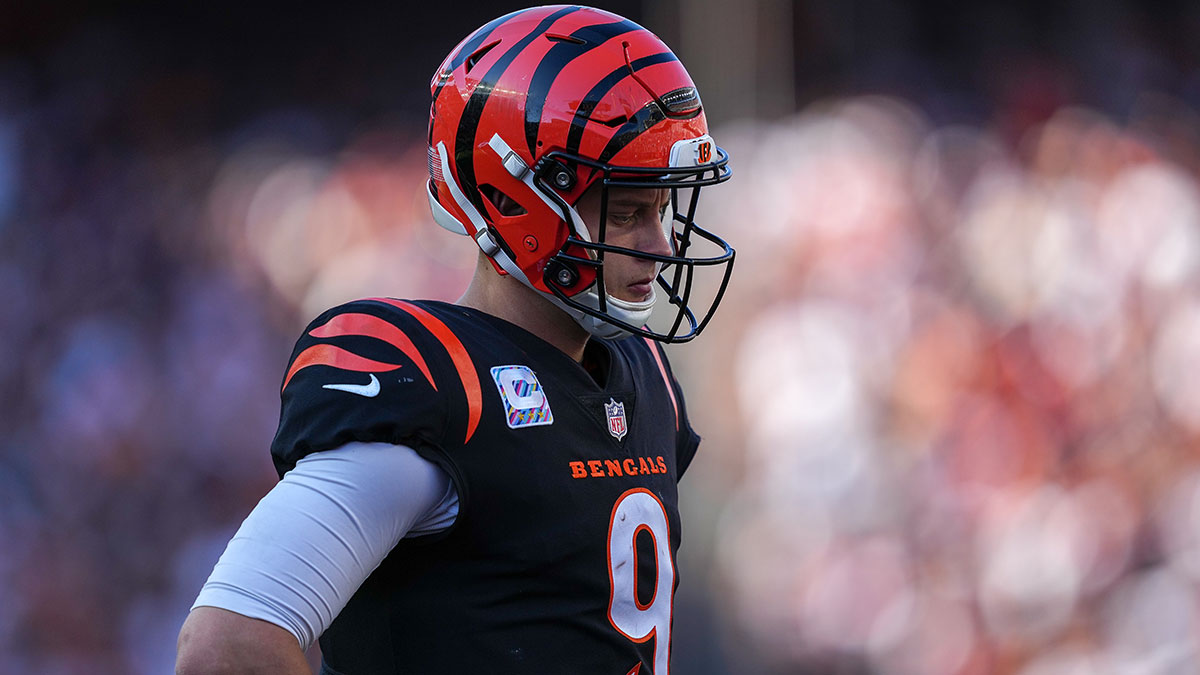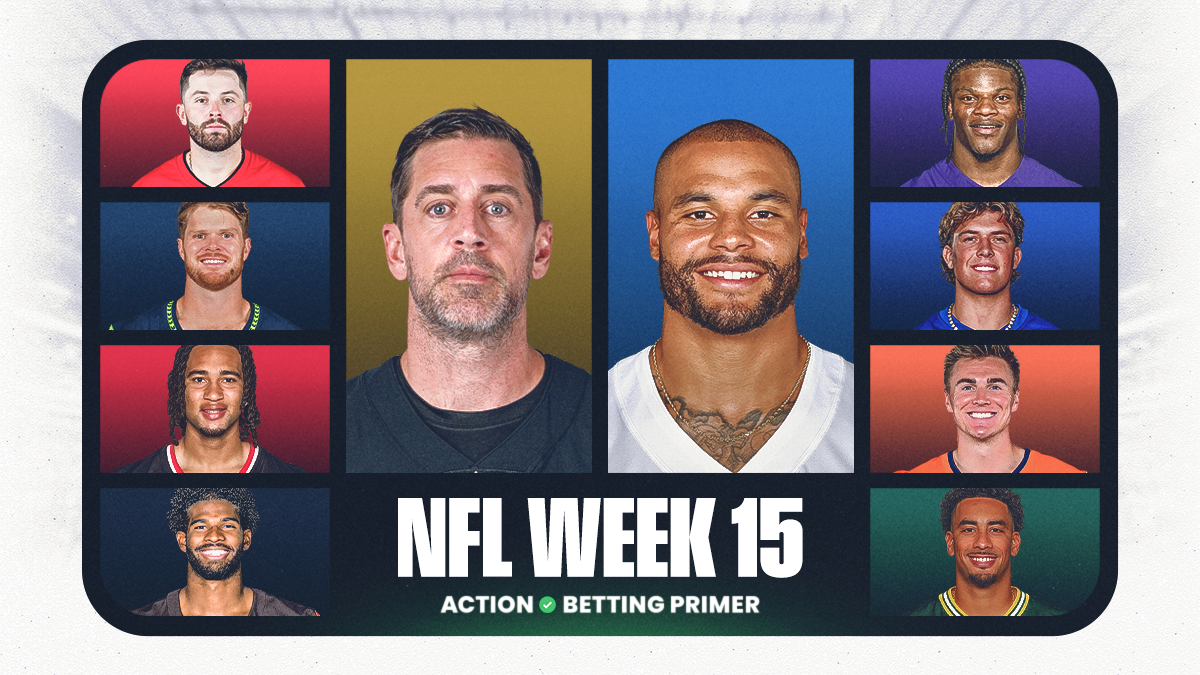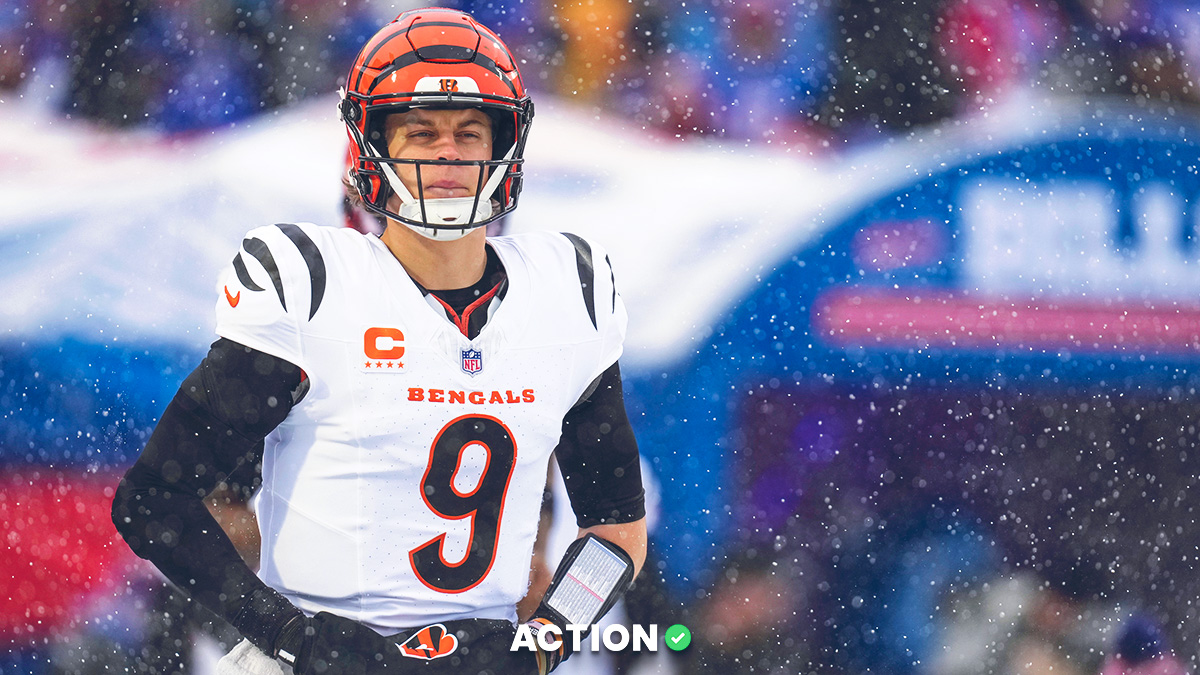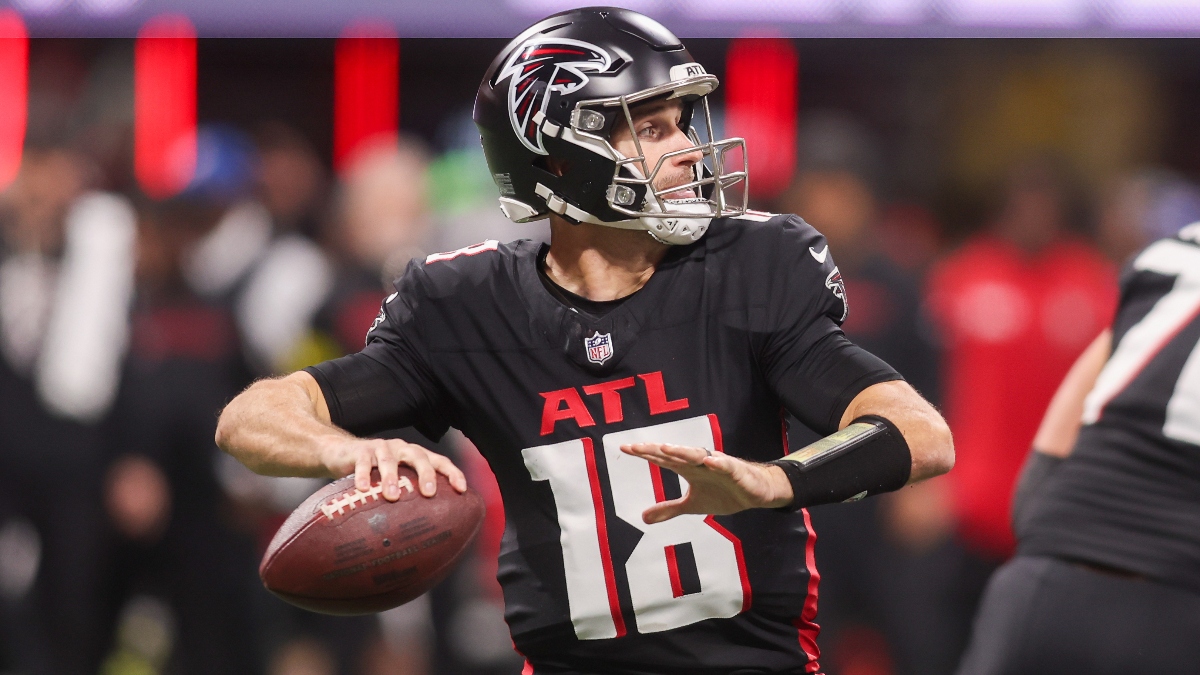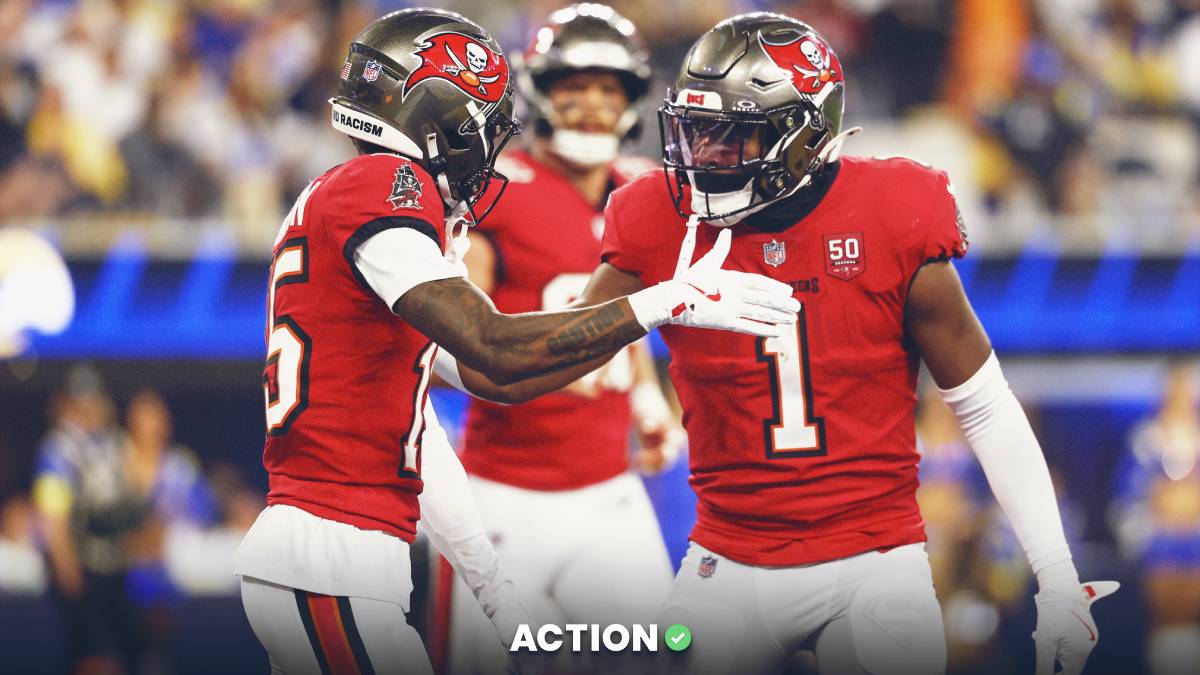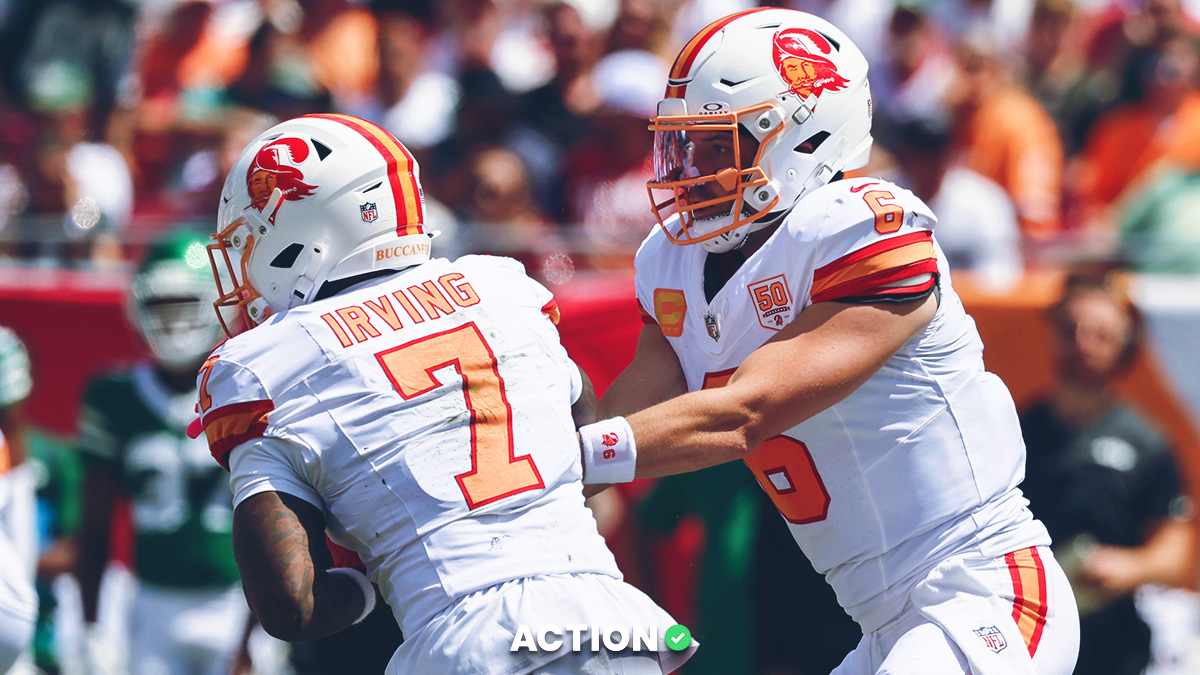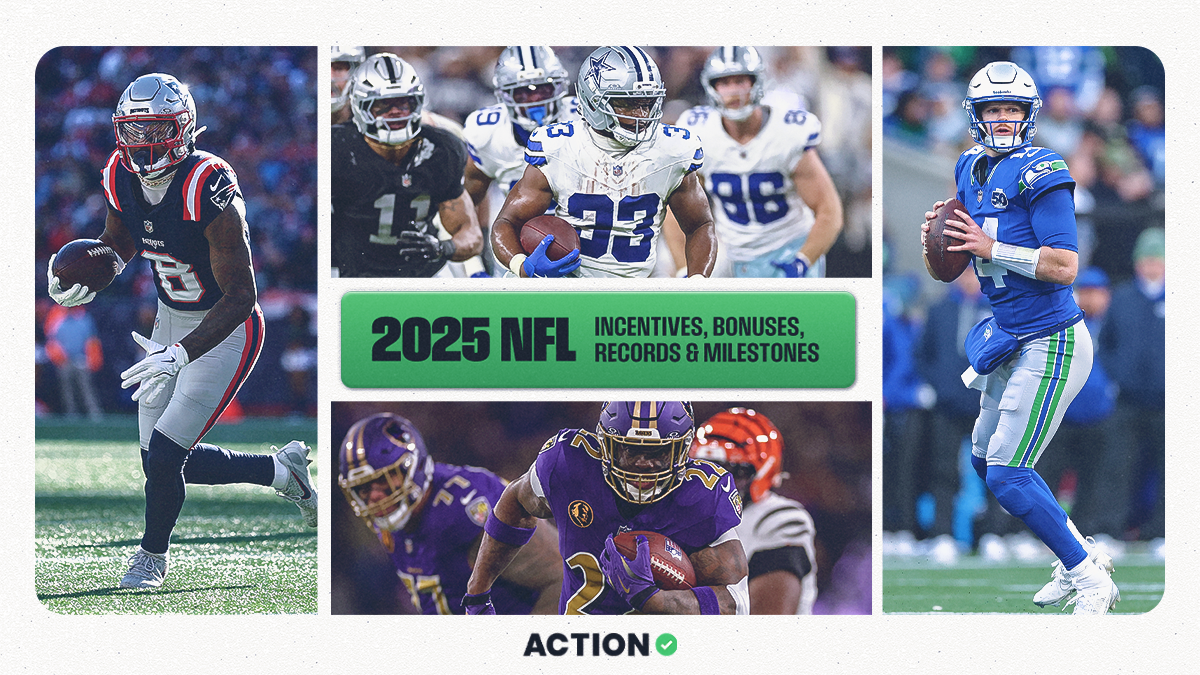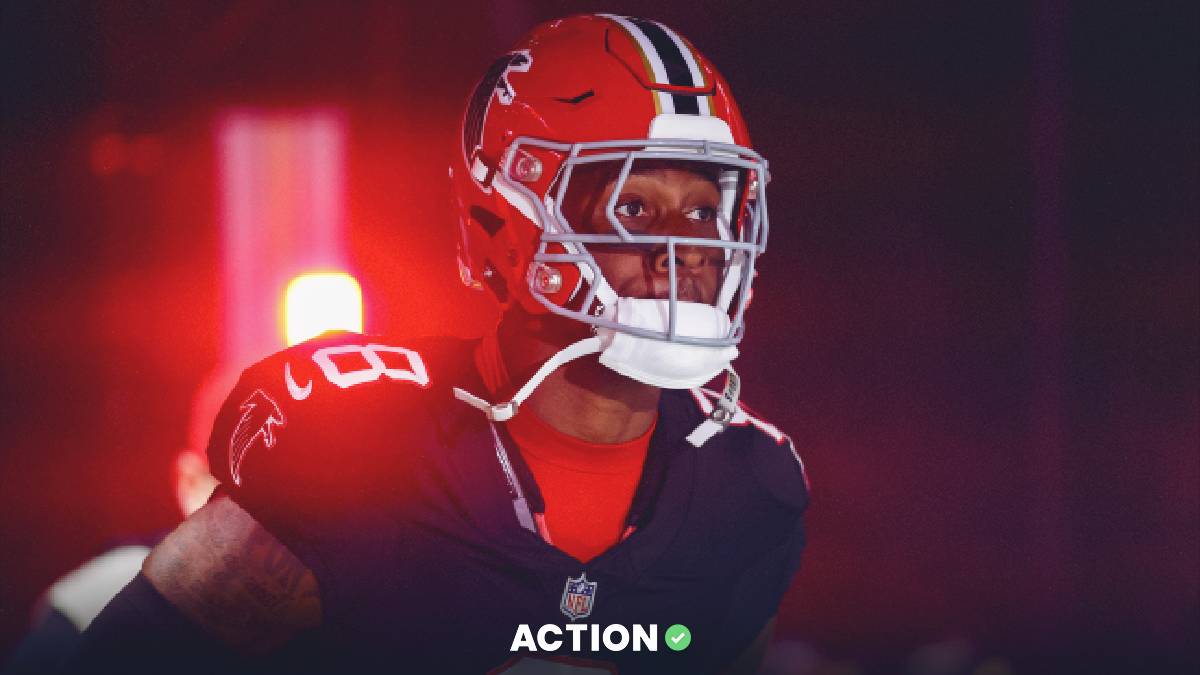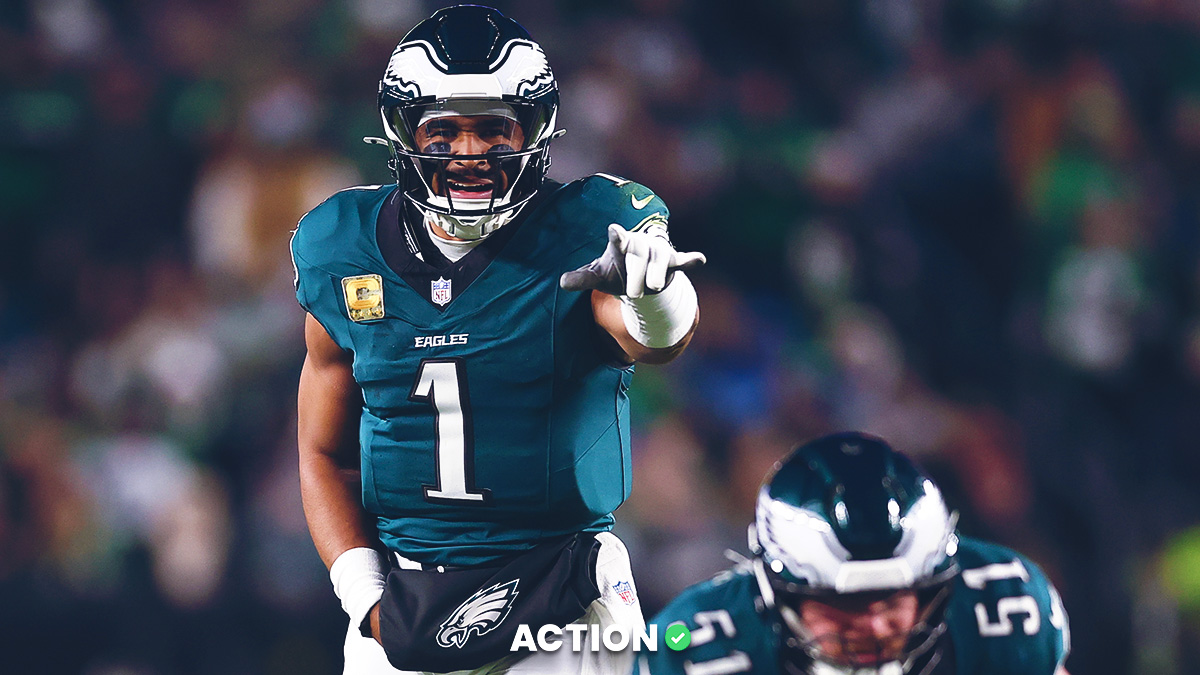- There are eight games at 1 p.m. ET in on Sunday in Week 9.
- Chris Raybon is looking to continue his season-long heater with five bets to kick off the slate.
- Check out his bets and breakdowns below.
NFL Week 9 Odds & Picks
Chris Raybon: The Bengals are in a tough spot. They’re coming off short rest and are missing their best receiver (Ja’Marr Chase), run defender (D.J. Reader) and coverage corner (Chidobe Awuzie).
On paper, the biggest concern with backing the Panthers is their pass defense, which ranks 27th in DVOA and 18th in Extra Points Added per dropback (0.079). Their metrics are misleading, however, as cornerback Jaycee Horn has missed over 30% of the defensive snaps, but he is healthy entering this matchup.
In 212 coverage snaps, Horn has been targeted only 19 times, allowing just eight catches for 46 yards and no touchdowns with one interception, per PFF. And don’t forget the Browns entered last week’s matchup against the Bengals ranked 28th in defensive passing DVOA, only to hold Joe Burrow to 193 net passing yards on 40 dropbacks, a performance which rocketed the Browns pass defense up 12 spots in DVOA to 16th.
Burrow’s history of struggling without Chase goes beyond Monday’s game in Cleveland. Below are his career splits throwing to Chase versus everyone else.
- Burrow to Chase: 10.3 yards per attempt, 16.1 yards per completion, 9.7% TD rate
- Burrow to everyone else: 7.6 yards per attempt, 10.6 yards per completion, 4.5% TD rate
Horn’s presence is huge here, as the absence of Cincy's No. 1 WR will allow him to focus his efforts on limiting Tee Higgins, who has been easier to corral without Chase.
Higgins was drafted a year before Chase, and his yards per target is 8.5 in games he’s played without Chase compared to 9.5 in games he’s played with. Tyler Boyd has seen an even bigger dropoff over that span, from 9.2 yards per target with Chase to 7.7 without.
The Panthers defense should be able to not only hold up in coverage, but also win in the trenches against a Bengals offensive line that has allowed 3.75 sacks per game (second-most).
Edge defender Brian Burns is seventh among all defensive players with 34 pressures and can line up on either side of the line, where he’ll face either left tackle Jonah Williams, whose 59.0 PFF pass-blocking grade ranks 59th of 74 qualifiers at tackle, or right tackle La’el Collins, whose 45.9 grade ranks 70th. The Panthers will also get Derrick Brown, PFF’s sixth-best interior lineman of 126 qualifiers, matched up with left guard Cordell Volson, whose 19 pressures allowed are tied for sixth-most among guards.
Burrow is unlikely to get much help from the running game against a stout Panthers run defense that is ranked seventh in DVOA and fourth in EPA per rush (-0.141). Joe Mixon is on pace for career lows in yards per carry (3.3), yards after contact per attempt (2.05) and missed tackles forced per rush (0.093).
When the Panthers have the ball, they’ll be facing a Bengals defense that has taken a significant hit due to injury. On the ground, the Bengals really miss Reader (IR; MCL), who isn’t expected back until after the bye. They had the fifth-lowest rush success rate (33.8%) during Weeks 1-3 with Reader, but have the fifth-worst (46.4%) since.
The Panthers are in position to capitalize despite trading away Christian McCaffrey, as their run game has rattled off at least 169 yards in both games sans CMC. D’Onta Foreman has been a revelation over the past two weeks, rushing 41 times for 236 yards (5.76 YPC) and three TDs.
In the secondary, the Bengals will sorely miss Awuzie, who limited opposing receivers to a 41.9% catch rate and 5.1 yards per target on 43 targets. He would have drawn the assignment against D.J. Moore, who is averaging 5.3 catches for 76 yards and 0.67 TDs in P.J. Walker’s three starts. Compounding matters, Cincy will also be without slot cornerback Mike Hilton (finger), PFF’s 37th-best corner among 110 qualifiers.
Walker is showing increased synergy with his offensive line — Carolina has allowed four sacks in his three starts after allowing 17 in its first five games with Baker Mayfield – and should have time to find Moore against a Bengals pass rush that ranks below average in pressure rate (22.0%; 18th).
The Bengals were eviscerated from a clean pocket by Jacoby Brissett, allowing him to go 14-for-17 for 234 yards and a TD when they failed to generate pressure. They struggled even when they did manage to get pressure, as Brissett completed 60% of his passes for 8.8 yards per attempt under duress.
According to our Action Labs data, Walker is 4-1 ATS in his five career starts, covering by an average of 16.5 points per game. Meanwhile, Burrow is just 1-4 ATS when favored by at least seven points, falling short of the closing number by an average of 5.3 points per game. And single-digit road dogs facing an opponent on short rest are 133-95-7 (58%) ATS since 2005.
When the total is 43 or fewer, that mark improves to 61-38-5 (62%), covering by an average of 2.72 points per game.
Chris Raybon: The perceived difference between these two teams is greater than the actual difference between them. Despite a 6-1 record, the Vikings have been outgained by opponents 383.1-345.7, on average. Meanwhile, the Commanders outgained the Packers (364-232) and the Colts (362-324) in Taylor Heinicke’s two starts.
Since benching cornerback William Jackson (who has since been traded) in Week 5, the Commanders are eighth in EPA per dropback (-0.063) after ranking 20th (0.199) over the first four weeks of the season. Washington plays the seventh-highest rate of man coverage, which has given the Vikings trouble, as they are averaging just 6.3 yards per targeted pass against man, which is 27th in the league (while their 8.5 mark versus zone is 10th).
Washington will also be the best pass rush Minnesota has faced. The Commanders have generated pressure on 26.0% of opposing dropbacks, fourth-best in the league. Kirk Cousins’ passer rating this season drops from 102.8 in a clean pocket (14th of 40 qualifiers) to 61.8 under pressure (26th).
Those splits have been even more drastic for Cousins on the road (88.1 clean, 46.0 under pressure) compared to at home (110.9 clean, 72.7 under pressure). Overall, Cousins is averaging just 5.9 yards per attempt and a 76.2 passer rating on the road compared to 7.1 yards per attempt and a 101.7 rating at home. Those struggles have hampered the offense, which ranks seventh in DVOA at home but 22nd as a visitor.
While the acquisition of T.J. Hockenson should help the Vikings, he doesn’t figure to be a huge factor in this matchup. He is unlikely to see a full complement of snaps given his limited knowledge of the playbook. And when he is on the field, he’ll be up against a defense that is third in DVOA on passes to tight ends and allows the fewest schedule-adjusted receiving yards per game to the position (27.1).
Cousins may not get as much support as usual from his normally reliable run game featuring Dalvin Cook and Alexander Mattison, as the Commanders' run defense ranks second in DVOA, third in EPA (-0.147) and fourth in success rate (35.4%).
When the Commanders have the ball, their offense also matches up well. Despite the strong play of Za’Darius Smith, the Vikings still rank below average in pressure rate (21.4%; 21st), and Heinicke has been tearing it up from a clean pocket with a 132.1 passer rating.
The Minnesota pass rush takes a hit with the injury to Dalvin Tomlinson (calf), whose 80.7 PFF pass-rushing grade ranks eighth of 108 qualified interior lineman. The Vikings don’t often try to manufacture pressure, blitzing at the fourth-lowest rate, but if they do decide to send extra rushers, Heinicke is beating the blitz as well to the tune of a 111.1 rating.
When Heinicke gets time, he should be able to find his favorite target, Terry McLaurin, against a defense that is ranked 32nd in DVOA against the opponent’s No. 1 wide receiver.
One of the main reasons the Commanders have been more successful with Heinicke is his chemistry with Terry McLaurin. The Ohio State product is averaging 5.5 receptions, 93.0 yards and 0.50 TDs on 8.0 targets per game with Heinicke compared to 3.7 receptions, 61.2 yards and 0.17 TDs on 6.2 targets per game with Carson Wentz.
Over the last calendar year, Heinicke is 8-2 ATS, with one of those losses coming by a mere half-point. Cousins, meanwhile, is just 13-22-1 (37%) ATS after a straight-up win as a member of the Vikings.
Chris Raybon: The post-Davante Adams Packers offense is a shell of its former self, averaging just 18.1 points per game (26th in the NFL). That could be a problem, even against the Lions and their horrific defense that allows the most points per game in the league (32.1).
I’ll get to Detroit's defense in a moment, but first let’s talk about its offense. While the Lions are averaging 10.0 points per game on the road — Jared Goff isn’t built to ball outdoors — look at how many points it’s taken to beat them at home:
- Week 1:Eagles 38, Lions 35
- Week 2: Lions 36, Commanders 27
- Week 4:Seahawks 48, Lions 45
- Week 8:Dolphins 31, Lions 27
It’s taken no fewer than 28 points to beat the Lions at home, and 75% of the time, it’s taken at least 36. The Packers haven’t scored 28 points in a game yet this season.
The Lions rank 29th in EPA per rush (0.049) over the full season, but those numbers are misleading. They were last over Weeks 1-4 (0.163), but 10th-best since Week 5 (-0.085). That means the Packers' main edge in this game will come versus a Lions pass defense ranked 32nd in DVOA.
This will obviously be the worst pass defense the Packers have faced, but Green Bay’s results against sub-par pass defenses don’t exactly inspire confidence:
- Week 8 at Commanders (28th): 191 net passing yards, 21 points
- Week 5 vs. Giants (24th): 207 net passing yards, 22 points
- Week 1 at Vikings (22nd): 227 net passing yards, 7 points
While I think the Commanders were better than their ranking — Week 5 was the first week they benched William Jackson, who was a liability in coverage — we’re still talking about a Packers offense that is averaging 208.3 net passing yards and 16.7 points per game against defense with an average DVOA ranking of 25th against the pass. Meanwhile, the Lions are averaging 35.8 points per game at home against defenses with an average overall rank of 13th in DVOA, including three in the top 15 — and thus, better than the Packers, who rank 22nd in defensive DVOA.
The Lions play man at the fourth-highest rate, and playing that coverage at a high rate will get you beat by a team with multiple elite wide receivers and/or a mobile quarterback, which is exactly what’s happened when the Lions have faced those types of teams.
Their defensive numbers against the Eagles, Seahawks and Dolphins are significantly worse than against teams with offenses that don’t have a mobile passer like Jalen Hurts or a pair of elite receivers like D.K. Metcalf/Tyler Lockett or Tyreek Hill/Jaylen Waddle:
- DET defense vs. PHI, SEA, MIA: 39.0 points, 495.3 total yards
- DET defense vs. WAS, MIN, NE, DAL: 27.0 points, 365.8 total yards
The Lions go from godawful to merely bad against offenses that closely resemble the Packers.
Green Bay is averaging just 6.8 yards per targeted pass against man coverage, 26th in the league, and Rodgers’ 20 total rushing yards this season rank 36th among quarterbacks. The Lions also have the element of surprise on their side, as the firing of defensive backs coach Aubrey Pleasant could bring about some schematic changes the Packers haven’t seen on tape. Any change is a positive one; there’s nowhere to go but up.
Like Goff, who is averaging 8.0 yards per attempt, 292.5 passing yards, 2.8 TDs and 0.5 interceptions at home but 7.2 yards per attempt, 244.7 passing yards, 0.3 TDs and 1.3 interceptions on the road, Rodgers has also struggled away from home.
- Rodgers at home: 7.24 YPA, 243.7 passing yards, 1.67 TD, 0.33 INT
- Rodgers on the road: 6.18 YPA, 213.8 passing yards, 1.60 TD, 0.60 INT
Note: I’m designating the London game as a road game for this analysis, although it counts as a home contest for the Packers in the official NFL record book.
The Packers have also struggled against the spread in Detroit in the Matt LaFleur era, going 0-3 ATS with a -8.0 ATS differential in three trips to the Motor City since he took over (0-2, -6.5 if you remove last year’s meeting in which the Packers rested starters in the second half).
Rodgers used to be money in divisional road games, going 16-7 (70%) ATS from the start of his career through 2015, per our Action Labs data. Since 2016, however, he’s just 6-11 ATS (35%) on the road in the division.
Teams on a four-game ATS losing streak like the Lions are 41-23-2 (64%) ATS in Weeks 6-9 since 2005. And divisional home dogs of less than six points are 7-4 (64%) ATS this season and 60-40 (60%) ATS since 2018.
Chris Raybon: Bills unders are 6-1 this season, with their lone over winning by just a half-point. There’s good reason to believe they’ll be 7-1 after this week’s matchup with the Jets.
The Bills hit that 6-1 under mark despite facing only two defenses that rate above average in DVOA: Titans (10th) and Rams (13th). Meanwhile, they faced four units ranked 22nd or below: Packers (22nd), Steelers (23rd), Chiefs (24th) and Dolphins (25th). The suddenly talent-laden Jets defense clocks in as the NFL’s eighth best through eight weeks, representing the best defense Josh Allen and company have faced all season.
No defense fully shuts down the Bills, but the Jets are a well-rounded unit that should make things more difficult than Buffalo’s other opponents.
The Jets rank eighth in DVOA against both the pass and run. They get pressure at the third-highest rate (26.4%) despite blitzing at the fifth-lowest rate (15.6%). The key player up front is Quinnen Williams, who has seven sacks (sixth) and 32 total pressures (tied for eighth) and has earned top-five marks from PFF for both his pass-rushing (88.0, fifth) and run defense (80.9, third). Williams should wreak havoc against a Bills interior line featuring Roger Saffold (45.3 PFF grade, 69th of 81 guards), John Bates (60.0 grade, 50th of 81 guards) and Mitch Morse (61.1, 20th of 37 centers).
Outside, they boast two cornerbacks that rank top five in PFF coverage grade in Sauce Gardner (86.9, second) and DJ Reed (81.9, fifth), which is key when going up against the likes of Stefon Diggs and Gabe Davis.
As good as the Jets are on defense, the Bills are even better. They rank fourth in overall DVOA and top five versus both the run (fifth) and pass (fourth). They’ve faced three top-five offenses — Kansas City (first), Baltimore (second) and Miami (fifth) – and held all three to 21 points or fewer. Against offenses ranked 20th or below like the Jets (21st), they’ve allowed 6.7 points per game with a high of 10. This should give them some wiggle room in the absence of Jordan Poyer, who wasn’t playing at an elite level like in years past, but still graded out in the 64th percentile among safeties at PFF.
It will be difficult for the Jets to consistently move the ball without Breece Hall, who averaged 5.8 yards per carry. Michael Carter is averaging only 3.5 YPC this season, and James Robinson averaged 3.4 in his Jets debut and 3.6 since Week 4.
Since Zach Wilson returned in Week 4, the Jets are converting just 35.3% of their third downs, 29th in the league over that span.
Per our Action Labs data, divisional unders in games played outdoors are 19-6 (76%) this season and 55-33 (63%) since the start of last season, covering by an average of 2.6 points per game.
Chris Raybon: The blustery winds of Soldier Field make for a good spot to sell high on these offenses after they were both involved in indoor shootouts last week. The forecast calls for winds in the 13-16 mph range; anything in the double digits can have an effect on the passing game and the kicking game.
Regardless of the weather, we already know the Bears want to keep it on the ground. Chicago’s 35.6 rushing attempts per game is a league high, and its 20.0 pass attempts per game is a league low. The Dolphins are ranked ninth on defense in DVOA against the run, which marks the third top-10 run defense the Bears have faced this season The results of the first two were what under bettors’ dreams are made of:
- Week 1 vs SF (3rd in run defense DVOA): CHI 19, SF 10 (under 38.5)
- Week 6 vs WAS (2nd in run defense DVOA): WAS 12, CHI 7 (under 38.5)
Note that both of those games took place at Soldier Field, where the under is 3-0 this season.
Although Miami ranks 29th on defense against the pass, this is not necessarily a good matchup for Justin Fields and company. The Dolphins dial up 11.3 blitzes per game, eighth-most, and despite Fields making a few plays against the blitz over the past few weeks, his 43.8 PFF grade when blitzed still ranks dead last among 39 qualified QBs.Not to mention, The Dolphins will be able to get more organic pressure as well with the acquisition of Bradley Chubb.
In terms of coverage scheme, the Dolphins play man at the third-highest rate in the league. N’Keal Harry, of all people, is the only Bears WR or TE who is averaging more yards per route against man coverage (2.13) than he does against zone (1.17). That includes No. 1 receiver Darnell Mooney, who suffers a 19.5% dropoff, and the newly acquired Chase Claypool, who suffers a 19.3% dropoff.
Mike McDaniel, Tua Tagovailoa and company have done a great job transforming this offense into one of the NFL’s most explosive units, so it’s easy to forget that the under is 4-2 in Tagovailoa’s six starts, including a 4-1 mark outdoors. The Bears 18th-place rank in pass-defense DVOA is seven spots better than a Steelers defense that Miami put up only 16 points against at home two weeks ago.
And while much has been made of the Bears defense trading away Robert Quinn and Roquan Smith, let’s take a moment to look at exactly what type of production they are losing:
- Quinn: 42.2 PFF grade, 114th of 117 edge rushers (second percentile)
- Smith: 50.8 PFF grade, 67th of 81 linebackers (17th percentile)
Quinn and Smith have had great careers and may very well go on to help their new teams, but in terms of on-field performance for the Bears, their departures are literally addition by subtraction, as every player slated to take on an increased role for this defense has graded out better so far this season.
Much will also be made of the Bears giving up 200 rushing yards and 49 points to the Cowboys last week, but again, perspective is needed, as the Cowboys rush offense is an elite unit that ranks second in the league in DVOA. In the prior three weeks, the Bears allowed 105.0 rushing yards and 18.3 points per game to teams whose rush offenses average out to a ranking of 18th in DVOA, which is more in line with what they’ll face against Raheem Mostert and the Dolphins, who rank 19th.
According to our Action Labs data, unders in 1 p.m. ET games with a total of at least 44 and winds of at least 9mph have gone 210-120-4 (64%) since 2003, covering by an average of 2.82 points per game.


